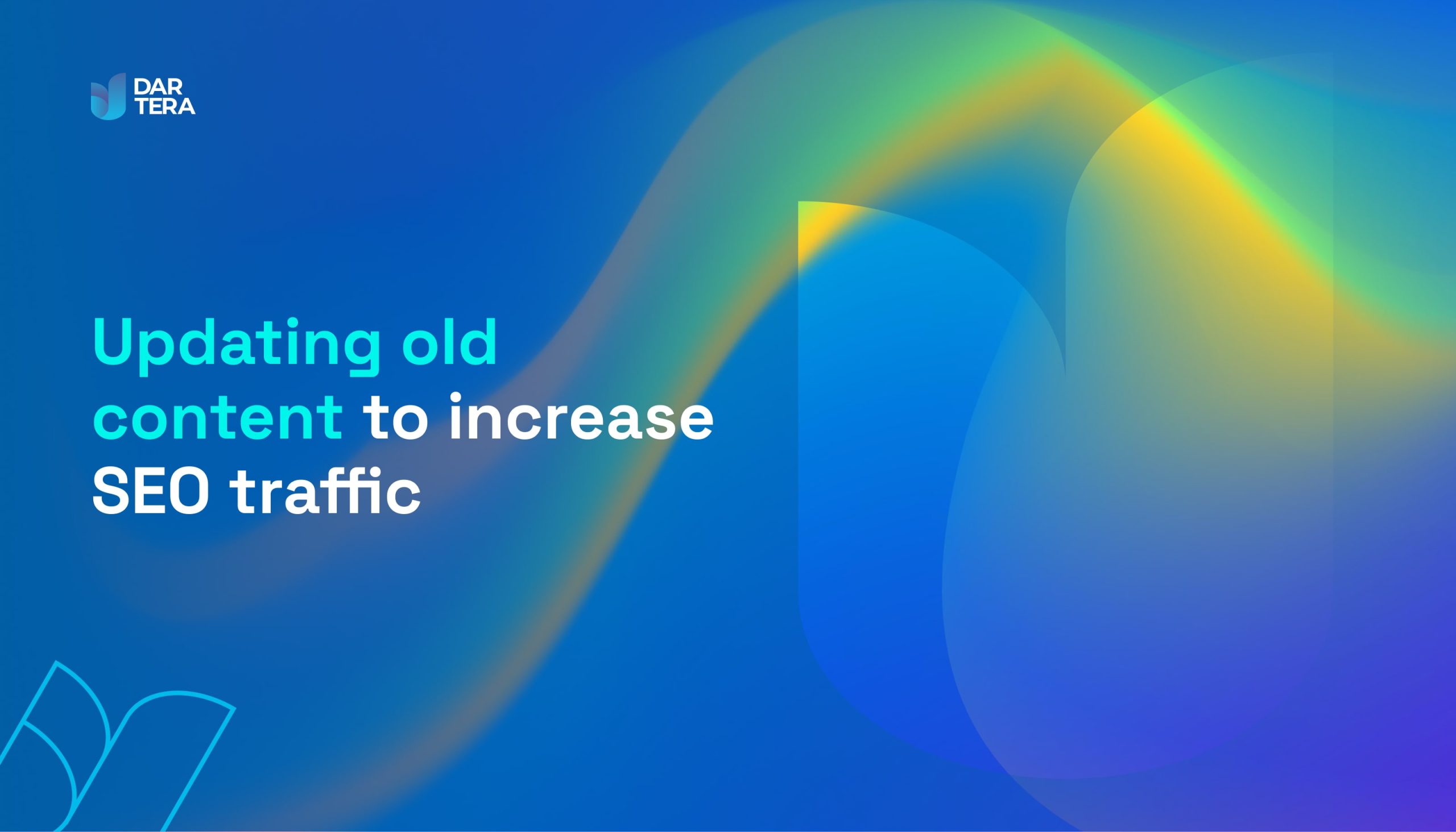Updating old content to increase SEO traffic

Sometimes the search engine optimization (SEO) solution a company needs most is right under its nose - or literally, right under its URL. Think of all the old content you may have on your website. When was the last time you checked them? If the answer was more than six months ago, it's time to take another look.
Content that was once on page one of the search engine results pages (SERPs) naturally loses value over time. You may have written an excellent paper in 2017, but who knows how many competitors have since created something newer and better - or, as we suggest here, revised their old work to surpass yours.
The best solution is not always the one that requires a whole new set of keywords, technical expertise, or an understanding of the inner workings of search engines. Displaying better, fresher content on your site can be as simple as contextualizing new links or removing low-quality pages. Practices that require expertise rather than SEO expertise can significantly increase your traffic.

What is Content Freshness?
Imagine if the news were never updated. Would you want to hear the same story every day? The same applies to the content of a website. While the content doesn't need to be updated every day - like the news, for example - it does need to be revised regularly to keep it "fresh."
Fresh content refers to dynamic content. It does not necessarily have to be associated with frequency, although the terms are not mutually exclusive either. We should not forget to mention that content freshness is one of many ranking factors for Google. It is called Query Deserved Freshness (QDF). QDF means that SERPs give priority to pages that match recent search intent. So if your content isn't updated with relevant keywords or doesn't match the intent and expectations of searchers, it won't perform as well as it might have once.

Why you don't always need new content
"Content is King" is true - but only if the content you publish is useful, relevant and fresh. All too often, content is equated with quantity instead of quality, or with creation instead of revision: the more content, the better. The less content, the worse. But that is not necessarily the case.
There is a time and place for new content, and figuring that out is an important part of improving your SEO rankings. So when should you create new content and when should you revise old content? This may depend on a few factors.
How old is your website? If you've been publishing content for 3, 5, or even 10 years, chances are it needs to be revised. If you started publishing content on your website without knowing anything about search engine optimization, chances are you haven't implemented search best practices.
Young websites with minimal content or older websites that want to target new keywords or expand link building opportunities are more likely to benefit from content creation services than the other examples mentioned.

Old content: improve or remove?
Once you've decided that revising content is better than creating it, the next question is: should you improve the old content or remove it?
Removal may be necessary if link building opportunities on a page are poor and the content is deemed beyond salvage. Alternatively, removal may be necessary if the topic has no keyword value. However, you must always keep in mind the purpose of a particular page. A product page may not be linkable, but it still belongs on your website.
Removing content from your website is usually due to one or more of the following main reasons: Cannibalization, irrelevance and quality. Conversely, content is in need of improvement when it does not deserve to be removed but could benefit from a revision.

How removing old content helps your website
Removing outdated content is called "content pruning" in the SEO world. When gardening, pruning can look and feel destructive, but when done right, it stimulates growth and promotes plant health. The same is true for websites that undergo content pruning.
The benefits of content pruning include increasing the overall quality of your website, improving usability, and making better use of your crawl budget, which is the time and resources search engines spend crawling your website and including the results in their indexes.
Reduce keyword cannibalization
Using a particular keyword on multiple pages doesn't help your ranking as you may think. If you use a keyword phrase too often, you're competing with yourself - lowering your authority more than if you just had a consolidated page.
In addition, Google announced in 2019 that its algorithm is working to remove duplicate listings from a single domain to promote site diversity.
If you want to publish a new piece of content, make sure you don't already have an article that targets the same keywords you want to use. If you do, you should simply remove the page.
Remove irrelevant pages
Irrelevant, priceless pages are of no use to readers or search engine crawlers. Rather, they waste crawler time and attention with pages that offer little keyword value, link networking, or traffic conversion. The more you waste your website's crawl budget, the less often search engines will visit it and index the content for ranking purposes.
For example, product pages for items you no longer offer should be removed. You may also want to remove irrelevant headings or sections from otherwise useful content.
Removing low quality pages
Similar to irrelevant pages, low-quality pages serve no purpose on your website. These pages perform poorly in several ways: they don't rank for meaningful keywords, attract little to no traffic, and offer no opportunities for link building.
However, not all pages need to have SEO value to be shortlisted. Content that does well on social media, attracts visitors or updates loyal customers should definitely be retained. All in all, you need to have a good reason for each page on your website. If you don't have a good reason, maybe it's time to throw a particular page on the trash heap.

How improving old content benefits your website
In addition to QDF ranking, there are countless other benefits that come from improving your website's content. This is mainly about improved user experience and better implemented SEO tactics.
Detect grammar and spelling mistakes
Grammar and spelling are not direct ranking factors for Google, but error-free content is an important aspect of the user experience. Too many misspelled words can lead to a negative user experience, which can ultimately affect your ranking. Reviewing old content gives you the opportunity to identify these types of errors.
You can also benefit from revising your copy to make it clearer and more concise. Read it thoroughly to find overly long sentences, digressive or disjointed phrases that should be removed.
Remove broken links
A helpful resource you linked to years ago may no longer exist or may have moved, resulting in what is known as a "broken link." This not only hurts your rankings, but also affects the overall user experience. No one wants to find a broken link when they are expecting a resource.
Fortunately, broken links are not too difficult to fix. For websites that use Google Chrome, there is an easy-to-use tool for checking broken links. A comprehensive technical SEO audit of your website can also help you find problems with links, among other issues that need to be fixed as part of a content refresh.
Link to better, newer resources
Data is important to support claims in an article, but data can quickly become outdated. If you wrote an article in 2015, you may have cited a source from 2012. Chances are good that newer and better data are now available. Your old sources might contain outdated information or even something that has since been proven wrong.
Any content that requires citations should be marked as a page that may be revised in the future. Research is constantly being updated, so keep your content current.
Contextualize new links
In addition to adding new resources, you can also improve your network of internal links. Think of all the content you've created over the years. Your most successful content, no matter how long ago, can be used to highlight newer pages. Simply put new links in the context of old pages to boost your overall link building campaign and increase your search engine traffic.
Optimize for keywords and phrases
Search behavior changes over time, and what may have been a valuable keyword phrase five years ago may not be today. In other words, keyword research conducted in the past does not always provide the best opportunities for today's searchers. Revising old content gives you the opportunity to re-evaluate your strategy and optimize for today's keywords and phrases, as well as underlying search intent.
Improve your click-through rate
The main search results usually consist of content published in recent years, depending on the urgency of the query. As times change, information becomes more available - and people are more likely to click on articles that have been recently published. This is all related to the timeliness of the content.
For websites that have been around for some time, revisions are critical to improve click-through rates. But a date change is not the only advantage. Your website can also benefit from an updated title tag and meta description. To create a click-worthy meta description, you should write something that is to the point but promises more detail and value on the page.
Add graphics and multimedia
Five years ago, you may not have had a budget for graphics or other rich media. If you have it today, incorporating various media is a must. From images to videos, these forms of art tend to attract more links than pages without graphic content - and links, of course, reflect well on the value and trustworthiness of your site to search engines.
Optimize for Mobile
In particular, old content may not be optimized for mobile devices. Revising your website's content to ensure it is accessible to mobile users will greatly expand your audience. This may be more of a technical issue than one of the content itself, but changing your website or page design can also be an opportunity to review all of the above and make sure your website is fully optimized from start to finish.








